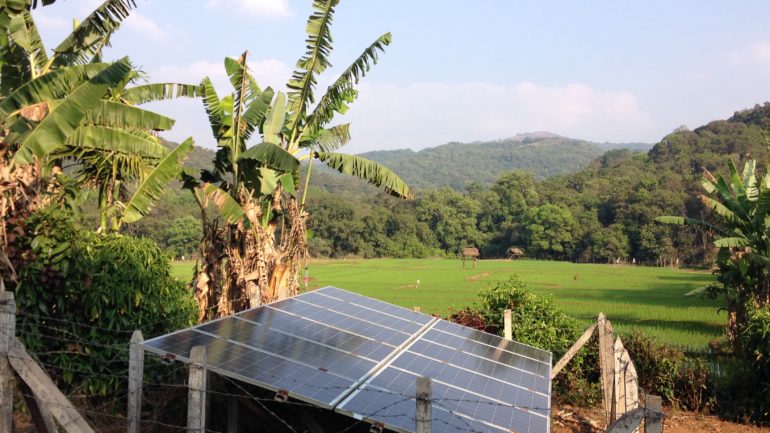Blog

Advancing electrification in rural India – reflections on grid connected and off grid solutions
In October 2017 the Government of India announced Saubhagya, a new policy aimed at “ensuring last mile connectivity and electricity connections to all unelectrified households in the country” by March 2019. The policy combines with the Deendayal Upadhyaya Gram Jyoti Yojana (DDUGJY) scheme, a village-level electrification agenda, to tackle grid connectivity at singular household level rather than on a village-by-village basis.
In the past years, grid infrastructure has been greatly extended and government figures report that grid connectivity is now available in 99% of Indian villages. Despite this progress, over 25 million rural Indian households remain unelectrified while many more are served by limited and unreliable supply.
Whether to supply to a lacking infrastructure or to provide an alternative to an inadequate and unreliable service, Decentralized Renewable Energy (DRE) solutions and small scale solar appliances such as Solar Home Systems are being deployed at scale in India, particularly in remote rural locations.
Whilst conducting an impact assessment on two Solar Micro Grids (SMGs) in the district of Uttar Kannada, Karnataka, I recently witnessed the many challenges posed by last-mile connectivity in rural parts of the country. The assessment was part of a wider study observing sustainability conditions for DRE systems across many dimensions; technical, economic, institutional, and socio-environmental.
The SMGs visited in the villages of Viral and Bhamane were installed by
Gram Oorja, a Pune-based social enterprise in partnership with a local trust. They installations provide 24×7 power supply to each house as well public lighting. Four LED bulbs, two sockets and a meter have also been installed in each house and the systems are designed to provide spare capacity to run small livelihood generating appliances.
Whereas installation costs have been covered via grant funding, recurring O&M costs are covered by energy tariffs collected from each house. Both sites use a community-ownership model, where a locally elected operator and Village Energy Committee work together to ensure technical and financial management of the plant on an ongoing basis.
After many years of successfully managing the solar grid with little external help required, both communities were recently provided with a connection to the central grid. In Viral the government lines arrived just one month before the visit, whereas Bhamane was connected over a year ago. Unfortunately however, the lines from the central grid only lasted for a few months until severe monsoon rains damaged the poles and disrupted the lines to the village.
While conducting the visit and interviewing the local residents, it was clear how user’s satisfactions and preferred choices for electricity in both cases lay with the locally managed SMGs. There were two key reasons reported for this preference.
A recurring remark from all interviewed houses was the high reliability and quality of power provided by the SMGs compared to that from the central grid. Respondents found it hard to precisely identify the number of disruptions or days without power experienced over the past month. “I cannot say” replied a man in Viral when asked about his experience with the central grid “electricity is available for 10 minutes then it may go off for an hour and come back again for some time. It goes on like this the whole day”. This service was compared to 3/4 days of disruption registered during monsoon months with the supply from SMG’s, hence making the experience with solar electricity much more appealing.
In such remote, rural areas unreliable electrical supply is not uncommon characteristic of the central grid, but it was nonetheless shocking to witness its extent. A service who varies on a minute-per-minute basis, falls short not only in promoting economic growth but also in meeting basic energy needs for households and public spaces.
The second main reason for the marked preferences towards the SMG was around the benefits of a locally managed service as compared to one perceived as distant and unaccountable.In the case of Bhamane, where the central grid only worked for a few months, community members were very surprised to see that no one had visited the village for over six months to check on the status of the grid line. Local accountability for the electricity supply seemed to be an additional decisive factor determining user’s choices and preferences.
Surprisingly, the economic reason of a free/cheaper electricity supply as provided by the central gird did not emerge as a determining factor for choosing one source as compared to another.
Overall, it seemed that the experience with the solar grid had set a baseline, defining attributes for reliability and accountability of an electricity service, a factor that may have plaid a determining role in the low satisfaction registered towards the central grid in these locations. This finding is in line with that from other studies; where user’s satisfaction and preferences were found to be subjective and contingent to pre-existing expectations and past experiences with electricity services.
As I left the villages that evening, I wondered what measures could be taken to tackle the issue of electrification in these and other remote villages more effectively. Certainly, a household approach as proposed by the Shaubgjya scheme offers a more inclusive solutions for universal electrification. However, modern, reliable and durable supply should be basic requirements for the energy service to be truly meaningful in the long run.
Additionally, a move to recognize the already existing DRE infrastructures implemented by various players in rural areas could be a meaningful step to avoid replicating efforts in places where a reliable and adequate service already exists.
